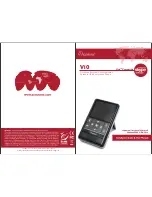
C
omrex
C
orporation
80
This encoder/decoder provides 7 kHz voice audio transmission with ex-
tremely low delay and extremely low network utilization. Due to its low
digital bandwidth, it is considered to be the most robust mode for use on
constrained networks. Here are some of the details of
BRIC-ULB
:
• Low Delay
—
BRIC-ULB
uses a 20mS audio frame, with an overall
encode/decode time of around 75mS. This makes BRIC-ULB a good
choice for real-time, interactive applications.
•
Low Digital Bandwidth
—
BRIC-ULB
has a data rate of around
12 kbps, allowing it to travel over very low speed networks. Also,
since BRIC-ULB is so efficient, error correction may be added in
many situations without congesting the network.
• Vocoder
—
BRIC-ULB
relies on a voice based vocoder, which is
the same principal utilized in many digital mobile phones. The dif-
ference is that while mobile phone vocoders typically provide about
3 kHz audio bandwidth,
BRIC-ULB
delivers more than twice that
fidelity, providing a much more listenable and less fatiguing sound.
BRIC-ULB
is optimized for human voices. It does a respectable job
of encoding background noise and crowds, but music tends to suf-
fer rather dramatically on
BRIC-ULB
.
• Mono
— Only a single audio channel is supported on
BRIC-ULB
.
• Dynamic Data Rate
— The
BRIC-ULB
encoder adapts its out-
going audio frame size based on the complexity of the incoming
audio.
This encoder does not compress audio at all. It uses a 48 kHz sampling
rate and simply applies small frames of linear audio to IP packets. This
mode is only useful on high bandwidth LAN or managed WAN environ-
ments.
Mono Mode
requires a network capacity of 768 kbps while
Stereo
Mode
requires a network bandwidth over 1.5 Mb/s.
This encoder compresses the audio data using a lossless algorithm. This
means that the audio extracted from the decoder is identical to the audio
input to the encoder, with no coding artifacts. FLAC typically removes 30-
40% of the network data compared to Linear PCM, but the actual data rate
is variable and is based on the complexity of the coded audio. Using FLAC
over Linear PCM typically results in a slightly higher (5ms) overall delay.
G.711 (µ-law and a-law) — These are the coding algorithms used by
standard digital POTS calls, and provide about 3KHz (telephone quality)
audio. µ-law is utilized in North America, while a-law is prevalent in Eu-
rope. These algorithms are provided for compatibility with SIP-style VOIP
phones, but don’t provide much benefit over standard telephony in audio
terms.
brIc-ulb
(u
ltrA
l
oW
b
ItrAte
)
l
IneAr
PcM
FlAc
g.711
















































